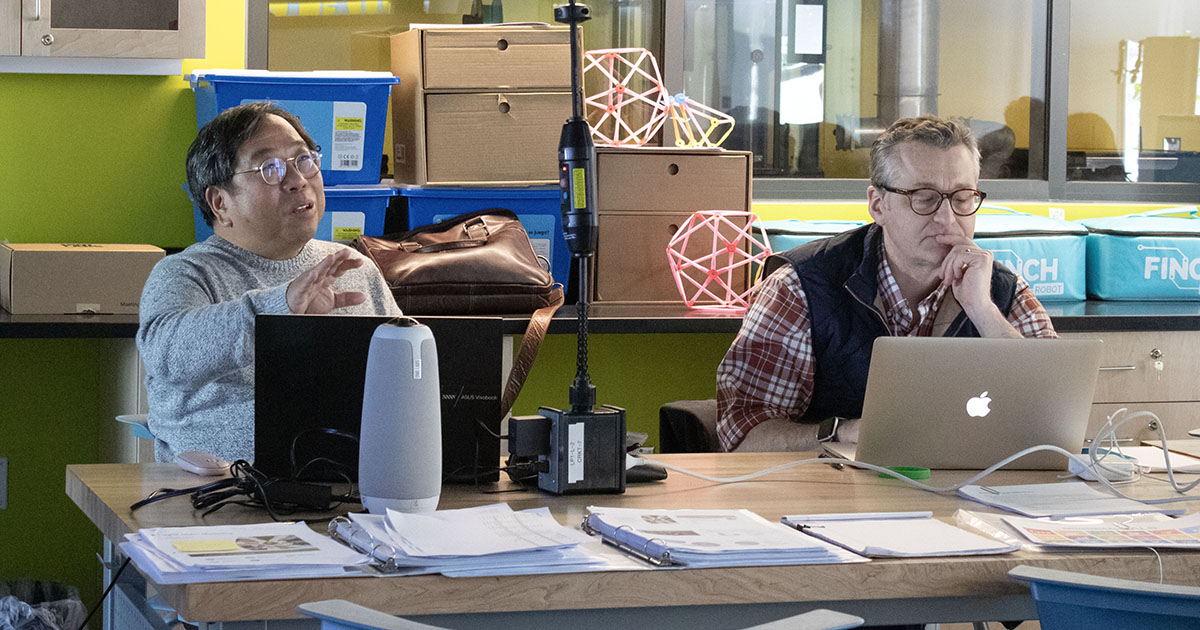
Category: Entomology and Wildlife Ecology

UD faculty members Mary Schorse and Chris Willliams aim to create educational sustainability modules for K-12 students in Delaware
June 03, 2025 Written by Nya Wynn | Photos by Jeremy Wayman
University of Delaware’s Mary Schorse, assistant research professor and director for the Delaware Center for Geographic Education, and Chris Williams, professor of wildlife ecology, received $425,000 through grants from Chemours Vibrant Community Program and the U.S. Environmental Protection Agency (EPA) Environmental Education Program to implement a three-year education and outreach program bringing sustainability into Delaware’s K-12 classrooms.
This project originated at Chemours, a Delaware-based chemical company, as part of the company’s commitment to advancing the United Nations’ 17 sustainable development goals that aim to end hunger and economic disparities worldwide, as well as increase knowledge about sustainable living practices.

Schorse became involved with the project through her role with the Delaware Center for Geographic Education and Williams became involved while he was the associate provost and academic director for the Office of Sustainability. With their collaborators at Chemours, Schorse and Williams aim to educate the next generation about the need to live sustainably as well as potential careers in sustainability.
“When the Office of Sustainability got set up, there was the hope to really think about teaching and research in an interdisciplinary way,” Williams said. “So it made a lot of sense that we wanted to promote sustainability, not only for our students, but also outreach to the community. That’s one of the core principles for a land-grant institution like UD – to think about outreach.”
The duo received their grant in July 2024. They began recruiting Delaware teachers, working with them through monthly meetings to make lesson plans accessible to their students. Their lessons will guide students through five modules covering topics from marketing and economics to technology relating to sustainability.
“What we realized very early on was that these lessons were written by scientists in the business world of a chemical company, and they needed some massaging by teachers currently in the classroom,” Schorse said. “We’ve had amazing feedback from these teachers on how to take these very complex concepts and connect them to real world experiences, making them relevant and exciting to the students.”
The learning modules cover topics from marketing and economics as well as technology and business. Williams worried that these concepts could be difficult to present to young minds, but he was pleasantly surprised that the teachers were ready for the challenge.
“We weren’t sure how it would be received, because it might feel too heavy tech and business to the point where students feel turned off by it,” Williams said. “And this still could be true, but the teachers are excited about it because they hope that it's going to teach students the ability to critically think about costs and benefits in their life.”
Students are constantly surrounded by the products of the decisions made by government organizations and companies, like the plastic water bottles they drink from or their favorite pair of blue jeans.
“We want to get them thinking,” Williams said. “Where did their fashion come from? Where did they buy it from? Is it fast fashion that’s just going to be dumped in a landfill in six months? We want these students to think through these costs and benefits and their place on the planet.”
This aspect of sustainability, the life cycle analysis, is heavily emphasized in the modules so that students can dissect the life of a product from development through disposal. In addition, students learn about risk assessment through an Interactive Hazard-Exposure Visualization tool designed by Chemours specifically for this project.
“It’s important for students to think about their choices,” Schorse said. “The pros and cons and how our decisions relate to sustainability. All the modules build up to a real world practical activity where students form a company and are required to make decisions about packaging and sustainability for their business.”
For the students’ final project, they will be given funds allocated from the grants to develop a project to implement in the respective school communities. Students will have to create a business proposal to address a sustainability issue they feel is occurring in their school and community.
The program is currently in its first year, where they’re working to refine the education modules with teachers before piloting the program to public schools in years two and three.
“It’s a multi-step process, and we are extremely grateful to have a couple of student interns helping us with this phase of the project,” Schorse said. “We have a UD earth science education major who is helping us with the writing of the lessons, and we have a College of Agriculture and Natural Resources student intern helping with some of the background work.”
The project was also inspired by the need for more professionals to have an understanding of sustainability even if their career does not directly relate to sustainability.
“The mindset to be able to think about sustainability is a skill set employers in all sectors are saying that they need,” Schorse said. “A paramount study by Microsoft that came out a few years ago identified a huge sustainability skills shortage. So we’re hoping to make a small dent into that.”
The importance of sustainability in all sectors is something that Williams and Schose want to emphasize, not just for College of Agriculture and Natural Resources or College of Earth, Ocean, and Environment students, but for everyone.
“We need a breadth of students that aren’t just ag-based or environment-based, or even engineering-based,” Williams said. “We must expand in business and the humanities. That’s the nature behind sustainability; it’s so broad, and it really does touch on every college at the University so students have many opportunities for their future.”
